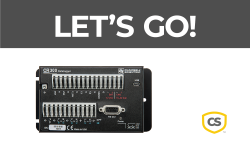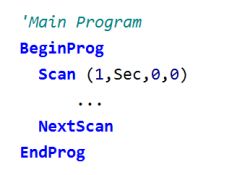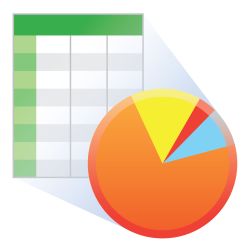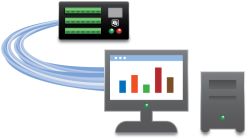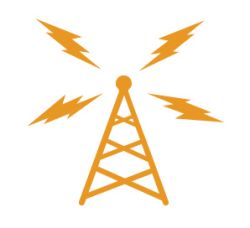This product is not available for new orders. We recommend ordering: CR350.
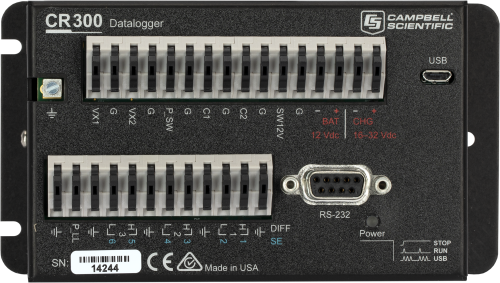
| Services Available | |
|---|---|
| Repair | Yes |
| Free Support | Yes |
Overview
The CR300 is a multi-purpose, compact measurement and control data logger. This small, low-cost, high-value data logger offers fast communications, low power requirements, built-in USB, and excellent analog input accuracy and resolution. The CR300 can measure most hydrological, meteorological, environmental, and industrial sensors. It concentrates data, makes it available over varied networks, and delivers it using your preferred protocol. It also performs automated on-site or remote decision making for control and M2M communications. The CR300 is ideal for small applications requiring long-term, remote monitoring and control.
The CR300 includes Wi-Fi, cellular, or the following radio options for different regions:
- CR300-RF407: US and Canada
- CR300-RF412: Australia and New Zealand
- CR300-RF422: UK and EU
- CR300-RF427: Brazil
Note: Campbell Scientific does not recommend the CR300 for use as a PakBus router in networks with more than 50 devices. Large arrays or string variables may also reach memory limits. For such applications, a CR1000X Measurement and Control Datalogger is recommended.
Read MoreBenefits and Features
- Connects directly to a computer's USB port
- Differentiates even slight changes in data values with higher resolutions measurements (24 bit Adc)
- Provides simple serial sensor integration and measurement with SDI-12 and/or RS-232
- Supports full PakBus networking
- Includes embedded web page for direct connection via web browser
Detailed Description
The CR300 is a low-powered data logger designed to measure sensors, analyze data, and store data and programs. A battery-backed clock assures accurate timekeeping. The on-board, BASIC-like programming language—common to all Campbell Scientific data loggers—supports data processing and analysis routines.
The CR300 wiring panel includes a switchable 12 V terminal, and analog grounds dispersed among six analog terminals.
Compatibility
Note: The following shows notable compatibility information. It is not a comprehensive list of all compatible or incompatible products.
Software
| Product | Compatible | Note |
|---|---|---|
| DevConfig | Version 2.12 or higher | |
| LoggerLink | Version 1.5 or higher | |
| LoggerNet | Version 4.4 or higher | |
| LoggerNet Mobile Connect | Version 1.1 or higher | |
| PC200W (retired) | Version 4.4 or higher | |
| PC400 | Version 4.4 or higher | |
| RTDAQ | ||
| Short Cut | Version 3.2 or higher |
Additional Compatibility Information
Sensors
With several channel types, the CR300 is compatible with nearly every available sensor. This includes analog output voltage (0 to 2.5 V) and current (0 to 20 mA or 4 to 20 mA) sensors, thermistors, and RTDs to name a few. It is also compatible with pulse or frequency output sensors such as anemometers, rain gauges, and flow meters. CR300 dataloggers are not capable of applying reverse excitation, and they cannot be used with some conductivity or soil matric potential sensors.
SDI-12, Modbus, and other serial sensors are supported with the RS-232 port and C1 and C2 as a Tx/Rx pair. The CR300 does not directly support RS-485 sensors.
Measurement & Control Peripherals
The CR300 is compatible with low current and voltage solid-state relays but not with SDM or CDM devices.
Software
The CR300 series is compatible with CRBasic (version 3.6 or higher).
Enclosures
An ENC10/12 or ENC12/14 enclosure is adequate for most CR300-based systems.
Communications
The CR300 can communicate with a PC directly via its USB port. Compatible telemetry devices include our RS-485 converters, digital cellular gateways, RF telemetry, and satellite transmitters (HDR GOES, Argos, Meteosat, Iridium, and Inmarsat). Data can be viewed on an iOS or Android device (requires our free LoggerLink app), CD295 DataView II Display, or other third-party devices.
| Data Logger Option | Communications Type | Integrated Communications Are Compatible with |
|
CR300-WIFI |
2.4 GHz, 20 MHz bandwidth |
Most other Wi-Fi devices, such as the CR310-WIFI, CR6-WIFI, NL240 |
|
CR300-RF407 |
902 to 928 MHz Frequency Hopping Spread Spectrum |
|
|
CR300-RF412 |
915 to 928 MHz Frequency Hopping Spread Spectrum |
|
|
CR300-RF422 |
868 MHz SRD860 LBT+AFA |
|
|
CR300-CELL |
2G Frequency Bands 850, 900, 1800, 1900 |
GSM/GPRS/EDGE (2G) |
Power
The CR300 uses an external power source and has a built-in charger/regulator. Intelligent power sourcing autoselects the highest voltage from three input sources (CHG, BAT, or USB) to operate in one of the following four modes:
- UPS (recommended) - A 16 to 32 Vdc source, solar panel (SP10, SP20), or power converter (29796) is used to charge a 12 Vdc battery, such as our BP7 or BP12.
- 12 Vdc battery or other reliable 12 Vdc source
- Charge only - DC power supply (16 to 32 Vdc)
- USB - Powered over 5 Vdc USB port for setup, programming, and testing (will not charge battery or boost USB power to provide 12 Vdc to the switched battery terminal SW12)
Specifications
| -NOTE- | Additional specifications are listed in the CR300-Series Specifications Sheet. |
| Operating Temperature Range |
|
| Maximum Scan Rate | 10 Hz |
| Case Material | Powder-coated aluminum |
| Analog Inputs | 6 single-ended or 3 differential (individually configured) |
| Pulse Counters | 8 (P_SW, P_LL, C1, C2, and SE1 to SE4) |
| Voltage Excitation Terminals | 2 (VX1, VX2) |
| Communications Ports |
|
| Switched 12 Volt | 1 terminal |
| Digital I/O | 7 terminals (C1, C2, P_SW, and SE1 to SE4) configurable for digital input and output. Includes status high/low, pulse width modulation, external interrupt, and communication functions. Exception: The SE4 terminal doesn't do external interrupt. |
| Input Limits | -100 to +2500 mV |
| Analog Voltage Accuracy |
|
| ADC | 24-bit |
| Power Requirements | 16 to 32 Vdc for charger input (CHG) (Current limited to 0.9 A maximum for power converter or solar panel input.) |
| Power Requirements | 10 to 18 Vdc for external batteries (BAT) |
| Real-Time Clock Accuracy | ±1 min. per month |
| Internet Protocols | Ethernet, PPP, RNDIS, ICMP/Ping, Auto-IP(APIPA), IPv4, IPv6, UDP, TCP, TLS (v1.2), DNS, DHCP, SLAAC, NTP, Telnet, HTTP(S), FTP(S), SMTP/TLS, POP3/TLS |
| Communications Protocols | PakBus, Modbus, DNP3, SDI-12, TCP, UDP, and others |
| CPU Drive/Programs | 80 MB serial flash |
| Data Storage | 30 MB serial flash |
| Idle Current Drain, Average | 1.5 mA (@ 12 Vdc) |
| Active Current Drain, Average |
|
| Dimensions |
13.97 x 7.62 x 4.56 cm (5.5 x 3.0 x 1.8 in.) Additional clearance required for cables and leads. |
| Weight | 242 to 250 g (0.53 to 0.55 lb) depending on communication option selected |
CR300-RF407 Option |
|
| Radio Type | Frequency Hopping Spread Spectrum (FHSS) |
| Output Power | 5 to 250 mW (user-selectable) |
| Frequency | 902 to 928 MHz (US, Canada) |
| RF Data Rate | 200 kbps |
| Receive Sensitivity | -101 dBm |
| Antenna Connector | RPSMA (External antenna required; see www.campbellsci.com/order/rf407 for Campbell Scientific antennas.) |
| Idle Current Drain, Average | 12 mA (@ 12 Vdc) |
| Active Current Drain, Average | < 80 mA (@ 12 Vdc) |
CR300-RF412 Option |
|
| Radio Type | Frequency Hopping Spread Spectrum (FHSS) |
| Output Power | 5 to 250 mW (user-selectable) |
| Frequency | 915 to 928 MHz (Australia, New Zealand) |
| RF Data Rate | 200 kbps |
| Receive Sensitivity | -101 dBm |
| Antenna Connector | RPSMA (External antenna required; see www.campbellsci.com/order/rf412 for Campbell Scientific antennas.) |
| Idle Current Drain, Average | 12 mA (@ 12 Vdc) |
| Active Current Drain, Average | < 80 mA (@ 12 Vdc) |
CR300-RF422 Option |
|
| Radio Type | 868 MHz SRD 860 with Listen Before Talk (LBT) and Automatic Frequency Agility (AFA) |
| Output Power | 2 to 25 mW (user-selectable) |
| Frequency | 863 to 870 MHz (European Union) |
| RF Data Rate | 10 kbps |
| Receive Sensitivity | -106 dBm |
| Antenna Connector | RPSMA (External antenna required; see www.campbellsci.com/order/rf422 for Campbell Scientific antennas.) |
| Idle Current Drain, Average | 9.5 mA |
| Active Current Drain, Average | 20 mA |
CR300-RF427 Option |
|
| Radio Type | Frequency Hopping Spread Spectrum (FHSS) |
| Output Power | 5 to 250 mW (user-selectable) |
| Frequency | 902 to 907.5 MHz/915 to 928 MHz (Brazil) |
| RF Data Rate | 200 kbps |
| Receive Sensitivity | –101 dBm |
| Antenna Connector | RPSMA (External antenna required.) |
| Idle Current Drain, Average | 12 mA (@ 12 Vdc) |
| Active Current Drain, Average | < 80 mA (@ 12 Vdc) |
CR300-WIFI Option |
|
| Operational Modes | Client or Access Point |
| Operating Frequency | 2.4 GHz, 20 MHz bandwidth |
| Antenna Connector | Reverse Polarity SMA (RPSMA) |
| Antenna | pn 16005 unity gain (0 dBd), 1/2 wave whip, omnidirectional with articulating knuckle joint for vertical or horizontal orientation |
| Transmit Power | 7 to 18 dBm (5 to 63 mW) |
CR300-CELL205 Option |
|
| -NOTE- | The CR300-CELL205 option is not compatible with a Verizon cellular network. |
| Certifications | IC (Industry Canada) 10224A-201611EC21A |
| Cell Technologies |
|
| 3G Frequency Bands | 850, 1700/2100 (AWS), and 1900 |
| 4G Frequency Bands | 700, 850, 1700/2100 (AWS-1), 1900 |
| Antenna Connector | SMA (External antenna required; see www.campbellsci.com/order/cr300 for Campbell Scientific antennas.) |
| SIM Interface |
3FF (6 position/contacts) Supports SIMs that require 1.8 or 3 V. |
| Radio Output Power |
|
| Radio Sensitivity Range | -99.5 to 110.5 dBm (10 M) |
CR300-CELL210 Option |
|
| -NOTE- | The CR300-CELL210 option is only compatible with a Verizon cellular network. |
| Cell Technologies | 4G (LTE CAT-1) |
| 4G Frequency Bands | 700, 850, 1700, 1900, 2100 |
| Antenna Connector | SMA (External antenna required; see www.campbellsci.com/order/cr300 for Campbell Scientific antennas.) |
| Power Consumption - Low Power Mode | 5 mA |
| Power Consumption - Idle | 35 mA |
| Power Consumption - Active | 70 mA |
| SIM Interface |
3FF (6 position/contacts) Supports SIMs that require 1.8 or 3 V. |
| Radio Output Power | 23 dBm on LTE |
| Radio Sensitivity Range | -99.5 to 110.5 dBm (10 M) |
CR300-CELL215 Option |
|
| -NOTE- | The CR300-CELL215 option is intended for use in EMEA countries. |
| Cell Technologies |
|
| 2G Frequency Bands | 900 and 1800 MHz |
| 3G Frequency Bands | 850, 900, and 2100 MHz |
| 4G Frequency Bands | 800, 850, 900, 1800, 2100, and 2600 MHz |
| Antenna Connector | SMA (External antenna required; see www.campbellsci.com/order/cr300 for Campbell Scientific antennas.) |
| SIM Interface |
3FF (6 position/contacts) Supports SIMs that require 1.8 or 3 V. |
| Radio Output Power |
|
| Radio Sensitivity Range | -99.5 to 110.5 dBm (10 M) |
CR300-CELL220 Option |
|
| -NOTE- | The CR300-CELL220 option is intended for use in Australia and New Zealand. |
| Cell Technologies |
|
| 3G Frequency Bands |
|
| 4G Frequency Bands |
|
| Antenna Connector | SMA (External antenna required; see www.campbellsci.com/order/cr300 for Campbell Scientific antennas.) |
| SIM Interface |
3FF (6 position/contacts) Supports SIMs that require 1.8 or 3 V. |
| Radio Output Power |
|
| Radio Sensitivity Range | -99.5 to 110.5 dBm (10 M) |
CR300-CELL225 Option |
|
| -NOTE- | The CR300-CELL225 option is intended for use in Japan. |
| Cell Technologies | 4G (LTE CAT-1) |
| 4G Frequency Bands | 800 (lower), 800 (upper), 850+, 900, 1800, and 2100 MHz |
| Antenna Connector | SMA (External antenna required; see www.campbellsci.com/order/cr300 for Campbell Scientific antennas.) |
| SIM Interface |
3FF (6 position/contacts) Supports SIMs that require 1.8 or 3 V. |
| Radio Output Power | 23 dBm on LTE |
| Radio Sensitivity Range | -99.5 to 110.5 dBm (10 M) |
Documents
Manuals
Technical Papers
- CR300 Series: CELL200-Series Cellular Module Firmware Update
- CR300-Series-WiFi Daughter Board OS Update Procedure
- Data Streaming
- The Link Budget and Fade Margin
- Line of Sight Obstruction
- Measuring a PRT or Thermistor without a Completion Resistor
- FTP Troubleshooting
- Modbus Troubleshooting Guide
- HTTP Troubleshooting
Compliance
- CR300 and 33201 EU Declaration of Conformity
- CR300 and 33201 UK Declaration of Conformity
- CR300 FCC Supplier Declaration of Conformity and FCC Statement
- CR300-CELL205 FCC Supplier Declaration of Conformity and FCC Statement
- CR300-CELL210 FCC Supplier Declaration of Conformity and FCC Statement
- CR300-CELL215 EU Declaration of Conformity
- CELL220 Supplier Declaration of Conformity
- CR300-RF407 FCC Supplier Declaration of Conformity and FCC Statement
- CR300-RF422 EU Declaration of Conformity
- CR300-RF422 UK Declaration of Conformity
- RF427 Brazilian Certificate of Conformity
- CR300-WIFI EU Declaration of Conformity
- CR300-WIFI UK Declaration of Conformity
- CR300-WIFI FCC Supplier Declaration of Conformity and FCC Statement
Videos & Tutorials
Downloads
CR300 Series OS v.11.02 (5.19 MB) 02-06-2025
This download is for the CR300 series of dataloggers including all CR300 and CR310 models. Execution of this download places the Operating System file(.obj) on your computer. It also updates the CRBasic Editor compiler and support files.
Why Update? This OS adds Campbell Cloud compatibility enhancements and resolves bugs found in the previous OS. See the revision history for a complete list. With this OS update, it is recommended that you also update the Device Configuration Utility to the most recent version so that new datalogger features are available in the utility.
Note/Warning: Campbell Scientific always recommends updating operating systems on site if possible. When remote updates are required, it is recommended that you implement the necessary precautions to handle unexpected OS upload complications. All datalogger settings should be retained when updated remotely. If you choose to roll back to a previous operating system, the datalogger settings will be reset to default.
Watch the Video Tutorial: Sending an OS to a Local Datalogger.
CR300 Series Wifi OS Update v.1.7.12 (1.97 MB) 05-13-2022
Manufacturer chipset maintenance update.
CR300 QuickStart Program (569 KB) 03-15-2016
The CRBasic program referenced in the CR300 QuickStart videos and manual.
Data Logger Wiring Excel Template (1 KB) 03-26-2024
This is a data logger wiring diagram spreadsheet template that accompanies the Wiring Diagram Video. The spreadsheet includes templates for CR6, CR1000X, CR300, CR310, and CR350 data loggers. The file is an Excel template and works best with Microsoft Excel.
Frequently Asked Questions
Number of FAQs related to CR300: 4
Expand AllCollapse All
-
No. The CR300 datalogger does not have the ability to do autobaud.
-
Verizon recommends using MIMO antennas because their 4G towers use multiple antennas for communication. If your modem has two separate antennas or a MIMO antenna (which is two antennas bundled in the same package), you may benefit from reduced signal reflections, more reliable data reception, and an increase in bandwidth.
While Verizon’s language indicates that MIMO antennas are required because they want to offer the best service possible to their users, technically, a MIMO antenna is not required for any of our products, including the CR300-CELL210 (which does not have a diversity port) and the RV50X and CELL210 (which do have a diversity port to accommodate MIMO antennas). Our users have found that a single antenna works well without noticeable issues.
-
The connector is designed to accept wire sizes from 14 to 28 AWG. Note: If you are using ferruled wire ends, reduce the maximum size to 18 AWG.
Case Studies
Overview In 2020, due to the COVID-19 pandemic, the Formula 1 World Championship calendar was subject......read more
The Port of Townsville Limited (POTL) is undertaking the Channel Upgrade (CU) project at a......read more
The Jukskei River is one of the largest rivers in Johannesburg, South Africa. The river......read more
Located beneath a steep canyon near Douglas, Wyoming sits LaPrele Dam, privately owned by LaPrele......read more
Introduction The Andes Mountains of Argentina are home to a rich and diverse group of organic......read more
Everglades National Park is the largest tropical wilderness in the United States and was created......read more
GKM Consultants was contracted by a nationally leading engineering firm to develop, commission, and install......read more
The Ministry of Transportation Ontario (MTO) is responsible for monitoring and managing the province’s road......read more
Articles and Press Releases
Blog Articles
-
What You Should Know: Improvements to SMSSend()

04-09-2021 Author: Dana Worley -
How to Easily Test Your Rain Gauge Calibration—and Avoid Errors

02-28-2019 Author: Mike Nelson -
How to Monitor Your Campbell Cellular Modem Data Usage: Part 1

01-16-2019 Author: Nathanael Wright -
Edlog Data Logger Support and You

12-05-2018 Author: Jacob Davis -
Technological Sunsets Don’t Have to Be Sad

10-03-2018 Author: Robin Deissinger -
7 Things You Should Know about New Cellular Options for Data Loggers

02-21-2018 Author: Gary Roberts -
Get Answers to Your Data Logger Questions Quickly

01-04-2018 Author: Michelle Welch -
How Safe Are Your Campbell Scientific Devices from KRACK?

10-18-2017 Author: Jacob Davis -
New Ethernet over USB Functionality for Data Loggers

08-30-2017 Author: Dana Worley -
Sending Email from Your Data Logger Just Got Easier!

01-25-2017 Author: Dana Worley -
Available Security Measures for Internet-Connected Data Loggers

12-07-2016 Author: Dana Worley -
10+ Reasons to Be Excited about the New CR300 Datalogger

03-16-2016 Author: Robin Deissinger
Newsletter Articles
Press Releases
Privacy Policy Update
We've updated our privacy policy. Learn More
Cookie Consent
Update your cookie preferences. Update Cookie Preferences

















